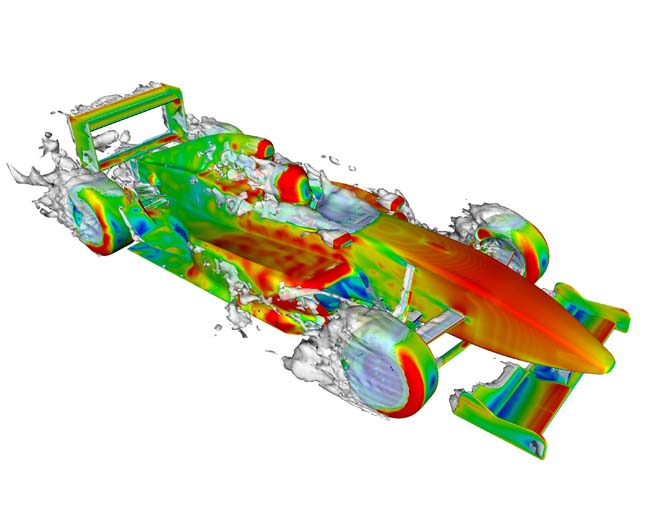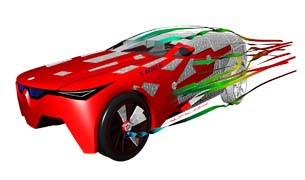December 2, 2009
By DE Editors
You want to create a CAE tool to aid and enhance a particular aspect of the design process, but your company doesn’t have the expertise to develop some of the required technology cost-effectively. How do you acquire the best-of-breed functionality that your project requires? Figure 1. Exa simulations early in the product development process allow engineers to evaluate and optimize designs long before physical prototypes are ever made. |
That’s precisely the situation Exa Corp. found itself in. The fruits of its efforts were introduced in 2009, in the form of PowerDELTA, a geometry preparation tool that promised to change the product development paradigm by streamlining the model preparation simulation process and opening use of powerful functionality to a broader pool of users.
The payoff for end users is early design optimization, reduced development costs, and accelerated time to market.
The Company
Exa Corp. is an engineering software company that offers a suite of CAE and CFD simulation tools, in addition to consulting services. Unlike most other CAE simulation software vendors, Exa provides solutions that bookend the development process—from model preparation to post-processing analysis—in a single integrated environment. The company’s core product is PowerFLOW, a computational fluid dynamics solver.
With engineering offices in the U.S., Asia, and Europe, Exa serves market-leading manufacturers of cars, trucks, trains, motorsport vehicles, and agricultural construction equipment.
 Figure 2. Exa PowerDELTA streamlines the model preparation process from CAD to simulation-ready. |
The Challenge
Many competitive case preparation tools require the customer to put facets on their CAD models or use external meshing tools to begin preprocessing. This makes it difficult to make corrections if there are problems. And if the file is in an IGES format, the model is always filled with problems. Correcting issues adds to the processing time.
Always looking to enhance and accelerate the product development process, Exa conceived the idea of PowerDELTA—a unique and innovative geometry prep tool—to add to its suite of CAE products and services. Exa product developers and managers, though richly experienced in the mathematics behind NURBS and solid modeling, quickly realized that developing the 3D geometry kernel and CAD format translators for the proposed new tool was not something they wanted to tackle.
“It’s one thing to have CAD surface functionality inside software that you’ve written to operate on NURBS surfaces—most of us have written those at some point,” says Paul Stewart, Exa Director of Product Management. “But to develop an actual CAD modeling kernel, along with the ability to convert many native CAD formats for PowerDELTA, was far too big a task and not part of our primary agenda, so it did not make sense for us to take it on ourselves.”
The Solution
Exa ran benchmarks to identify the geometry kernel that would best integrate with PowerDELTA. A number were discounted early on, with Spatial’s ACIS and (Siemen’s) UGS’ Parasolid making the short list. Ultimately, Spatial’s ACIS kernel and 3D InterOp translator components were selected for their breadth of capability in handling all native CAD formats, particularly CATIA v4 and v5 and Pro/E, essential to the auto and transportation industries.
Once the selection was made, integrating ACIS with different functionalities for meshing and wrapping were developed simultaneously, with the InterOp integration done later in the cycle. According to Stewart, this was the most critical aspect in the first release of PowerDELTA. Integrating InterOp with PowerDELTA enables Exa customers to import the original CAD model data without inheriting translation problems.
ACIS holds solid models read in by PowerDELTA. “It is appealing to us to have an actual CAD format inside the tool,” notes Stewart. “Even though we are a meshing tool, the ability to perform CAD operations on the initial geometry was a very attractive plus.” It’s one thing to read in CAD surfaces and then maintain them as CAD surfaces, but with the ACIS kernel, Exa customers use CAD model functionality to enhance the meshing process.
“There is a wealth of functionality in Spatial’s 3D components,” says Stewart. “We plan to use advanced covering (to create high-quality n-sided surfaces) and defeaturing (to identify and remove unwanted features from a 3D model prior to meshing) for future functionality.”
| “Partnering with Spatial allows us to outsource a very important and major component of our software. I appreciate Spatial’s responsiveness to our requests for feature and functionality enhancements that will enable us to accomplish our goals.” Paul Stewart, Director of Product Management, Exa Corporation |
Exa has found Spatial’s support services to be very helpful, and it sends an engineer to the annual Spatial Insiders’ Summit and workshops. The company has also used phone support to communicate issues directly with Spatial for resolution.
PowerDELTA
In 2009, Exa introduced PowerDELTA, which applies parametric feature modeling and history tree model management to simulation model creation and updating. PowerDELTA’s simplified and automated approach to geometry modeling and mesh preparation enables people with less specialized training to participate in the process; geometry application engineers and other users to quickly and efficiently prepare models for simulations; companies to devote fewer resources to mesh preparation; and design teams to optimize products early in the design process (Figure 1). By reducing the tedious preparation time, experts are free to think about high-level dynamics and real design problems rather than the meshes and facets associated with prep work (Figure 2).
What sets Exa apart from its competition is that PowerDELTA is a genuine process tool. A customer starts with a full bill of materials for the entire model; brings it in from the originating CAD system; and with a process audit trail, organizes, sorts, and prepares each of the many components—as many as 5,000 for some. Any changes are easily rolled through the whole process again because they are recorded in the process history tree—a trail of all geometric operations that have been performed in PowerDELTA.
The trail makes it easy to go back to either change the input geometry or change the meshing parameters and quickly regenerate the entire sequence of operations. Unlike typical meshing tools, where the user is just pushing points around without knowing where he started, ACIS enables PowerDELTA to function like a solid modeling tool because of the history tree.
For example, an OEM customer of Exa’s may bring a CAD model with thousands of parts into PowerDELTA. The software prepares the entire vehicle by sorting it into perhaps 100 individual mesh components. When the process is complete and the model is ready for simulation, invariably a client has forgotten to provide a number of parts or some of them are wrong. Traditionally, the OEM customer would have to throw away several days of work and start over because the missing or wrong parts are so deeply worked into the final components.
With PowerDELTA, because the entire process has been recorded, it’s easy to change some parts at the start of the process and then regenerate the whole tree, quickly getting back to a completed model. Where the original model took four or five days to complete, depending on what was changed and where the modifications were in the vehicle, changes or variations are now completed in less than a day, or even in hours, thanks in part to ACIS. Once pre-processing is complete, the model is ready to be exported into PowerFLOW for solving.
Benefits of the Combination
Spatial components enable Exa to approach vehicle product development as a process problem by offering a soup-to-nuts digital simulation solution, a trend that the industry as a whole is embracing. PowerDELTA represents a milestone for the company because it consolidates functionality of several modules, eliminating the need for customers to rely on multiple tools for case preparation.
“We have a lot of experience in CAD mathematics, functionality, and software, but we need to focus our resources on our core business of solving engineering problems associated with computational fluid dynamics analysis,” comments Stewart.” “At the same time, we need serious, competent help on the CAD development side. Partnering with Spatial allows us to outsource a very important and major component. We view them as an extension of our development team.”
“We work closely with our clients to resolve design issues, not just by providing them with software to work on their own, but by truly understanding the client’s real engineering problem,” concludes Stewart.” Spatial approaches its client relationships in much the same way, which is integral to our partnership.”
With the Exa suite of engineering simulation products, engineers achieve results within time frames that, in many cases, are unreachable using traditional methodologies. As a result, customers significantly reduce prototype expenses and bring their products to market faster.
More Info
Subscribe to our FREE magazine, FREE email newsletters or both!
About the Author
DE’s editors contribute news and new product announcements to Digital Engineering.
Press releases may be sent to them via [email protected].






